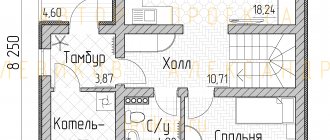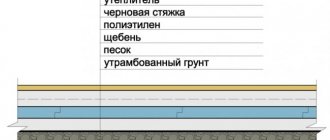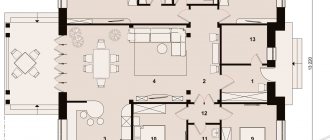Failed Soviet aircraft carriers: Project 72 in the face of problems
The further work on Project 72 progressed, the more unexpected problems faced Soviet engineers, and the more clearly they realized the depth of their ignorance of the “aircraft carrier” topic... As a result, the project was never implemented, and shipbuilders began designing a smaller aircraft carrier.
Aviators' opinion
On May 29, 1944, the leadership of the Navy Air Force reported to the Shipbuilding Directorate (UK) that neither it nor the Fleet Intelligence Directorate had sufficient materials to develop tactical and technical requirements for the aircraft carrier's aircraft armament. There were also no people familiar with the structure of foreign aircraft carriers - in connection with this, it was proposed to send a group of specialists to England and the USA to gain the necessary experience. Each group was to include two engineers from the design organizations of the People's Commissariat of the Shipbuilding Industry, one or two engineers from the Department of Shipbuilding and the Navy Air Force, one naval pilot and one specialist from the Main Naval Staff.
On June 30, the head of the Criminal Code N.V. Isachenkov approved this decision and said that the preliminary design project 72 is being considered by the fleet leadership and will be submitted for approval in July, therefore the conclusion of the Main Directorate of the Navy Air Force on its aircraft unit must be sent no later than July 10. In fact, this document arrived only on July 28, half a month late. It stated that:
“The preliminary design design of TsKB-17 is the first attempt to figure out the TTE [tactical and technical elements - approx. author] and aircraft weapons of a completely new class of ship for the USSR. The lack of technical requirements and operational materials for foreign aircraft carriers and the experience of their combat use in the current war at sea makes it extremely difficult to correctly resolve all issues, both for the contractor and the customer. Therefore, it is the development of a small aircraft carrier that makes the most sense.”
On this basis, the aviators actually avoided evaluating the project presented to them and limited themselves to general considerations for the design of aircraft carriers:
“This conclusion concerns only the main issues and is based on some information on aircraft carriers from foreign periodicals and discussions of some issues with representatives of the Navy Air Force.”
The conclusion of the Main Directorate of the Navy Air Force confirmed the opinion of TsKB-17 that it was inappropriate to place 45 aircraft on the ship due to the irrational use of hull volumes. It also noted that British and American aircraft carriers, similar in size to Project 72, have different aircraft capacities - for example, American Essex-class ships carry 100 aircraft each. It was explained like this:
“According to the English point of view, the aircraft carrier’s aircraft capacity is determined by the area of the hangars, since storing aircraft on the flight deck in stormy weather is excluded. The Americans also take into account the placement of aircraft on the flight deck in excess of the standard hangar capacity. It is not possible to establish which point of view is more correct and confirmed by the experience of the war.”
At the same time, it was pointed out that on foreign aircraft carriers some of the aircraft were stored disassembled, which made it possible to increase the composition of the air group. The need to provide space for aircraft repairs was also noted. It was proposed to determine the supply of fuel and aviation ammunition on the basis of two sorties per day over a five-day autonomous voyage.
American Essex-class aircraft carrier with aircraft on deck Source – navsource.org
In order to determine the dimensions of the takeoff and landing zones, as well as the optimal location of the “island,” it was necessary to conduct special studies of the take-off run and mileage of the torpedo bombers designed by plant No. 458. In addition, it was planned to test a mock-up of the flight deck at a land airfield at the Air Force Research Institute. The negative attitude of the aviators towards the deployment of universal artillery in the area of the “island” was especially noticeable - the pilots suggested leaving places here for temporary cleaning of aircraft after landing. The aviators also pointed out that “due to the lack of necessary information about the arresting device on foreign aircraft carriers, the question of its placement, as well as the size of the landing zone, remain open.”
It was proposed to consider only two types of aircraft as the main aircraft armament of an aircraft carrier: fighters and torpedo bombers. The deployment of auxiliary aviation was also allowed: communication aircraft, rescue, ambulance and even transport aircraft. It is characteristic that dive bombers were not mentioned at all! The optimal ratio of fighters to attack vehicles was assumed to be two to one, but it was indicated that it could vary depending on the specific mission. As for the small aircraft carrier, it was proposed to take into account the option of placing only fighters on it.
The Main Directorate of the Navy Air Force also found it difficult to indicate the characteristics of the aircraft intended to arm the aircraft carrier. It reported that tests of prototype torpedo bomber bombers were just beginning, “naval air force assignments for the fighter and flying boat have not yet been issued due to the current lack of free design bureaus in the People’s Commissariat of the Aviation Industry.”
. Things were even worse with aerofinishers and catapults: no one knew what to do with the former - only one plant in the USSR produced catapults, and even that one was fully loaded with work. In addition, the aircraft carrier did not require a rotating catapult for the on-board reconnaissance aircraft, which is common on artillery ships, but a more powerful one, recessed into the deck.
Thus, in order to begin research work, it was necessary to find out who would do it. As a result, only on December 4, 1944, the head of the Scientific and Technical Committee of the People's Commissariat of the Navy, engineer-rear admiral Alekseev, asked the head of the Navy Air Force, Marshal Zhavoronkov, to include in the plan of Research and Development Work for 1945 the topic “Landing and takeoff of aircraft based on an aircraft carrier.” "
The management company makes a decision
On August 28, 1944, the Shipbuilding Department finally issued its conclusion on the preliminary design of the aircraft carrier prepared by TsKB-17. In conclusion, it was noted that three project options were considered:
- the first (I-B) is a two-hangar for 60 aircraft with a citadel protected from 130 mm shells and effective mine protection. Artillery weapons - eight B-2U installations, sixteen 85 mm and forty-eight 25 mm barrels;
- the second (II-B) is the same large two-hangar version, but with twelve deck-tower installations in sponsons;
- The third (III-M) is a single hangar for 30 aircraft.
The first two options had a displacement of slightly more than 30,000 tons, the third - 23,700 tons. The full speed of the ships was supposed to be 30 knots, range (18-knot speed) - 10,000 miles, flight deck length - 273 (I-B, II- B) and 242 m (III-M). In the table attached to the conclusion, Project 72 was compared with foreign analogues - the German “Graf Zeppelin” and the English “Illustrious”.
English aircraft carrier Illustries Source – militaryhistory.x10.mx
In conclusion, it was concluded that “the presented materials are quite sufficient to make a decision on the type of aircraft carrier and technical specifications for its main elements”
. It turned out that different aircraft capacity with the same requirements for protection, armament and speed of an aircraft carrier has little effect on its main dimensions and displacement (at the same time, a two-hangar ship had a significant advantage over a single-hangar ship). From this the conclusion was drawn:
“It is recommended to build a “large” aircraft carrier, which has a relatively higher displacement utilization rate compared to a “small” one, and better seaworthiness and combat qualities.”
The Shipbuilding Department agreed that instead of the B-2U turrets, it would be better to install paired deck-tower installations on the ship, placing them side by side on the sponsons. 85-mm anti-aircraft guns were considered unnecessary, and at their expense it was proposed to increase the number of anti-aircraft guns, increasing their caliber from 37 to 45 mm and increasing the number of barrels to 60. At the same time, there was no need for 23-mm guns, and their number could be reduced to 10 -12. The requirement for general stabilization of the ship (due to the pitch control system) made it possible to abandon the stabilization of artillery installations. At the same time, the amount of ammunition could even be increased (compared to OTZ).
It was also proposed to consider the possibility of strengthening the protection of the flight deck and armoring the ends. As a result, the vital parts of the ship received protection not only from the fire of destroyers, but also from the artillery of light cruisers, as well as 500 kg of high-explosive bombs dropped from altitudes of up to 3000–4000 m. It also seemed possible to increase the depth of mine protection in the middle part of the ship to 7 m, which was higher than that of foreign aircraft carriers and even cruisers of the Kronstadt type (Project 69). If all these wishes were fulfilled, the aircraft carrier’s displacement would increase by 5000–6000 tons and would “catch up” with the performance of the then “Washington” battleships.
To achieve a 30-knot speed, the ship required a three-shaft power plant with a capacity of 168,000 hp. With. - that is, a third machine-boiler unit and another shaft were added to the two-shaft power plant of the Project 68 cruiser. However, the Shipbuilding Department decided that “taking into account the need for additional maneuvering of the aircraft carrier, its speed should be 3-4 knots higher than the speed of the squadron.”
From this it was concluded that with the speed of the designed battleships of Project 23 (Soviet Union) being 28–29 knots, the aircraft carrier should reach a speed of 32–33 knots, which would require equipping it with a four-shaft installation with a capacity of 224,000 hp. With. - that is, more powerful than on the battleships themselves.
The requirement that the speed of an aircraft carrier be 3-4 knots higher than that of a squadron seems very strange, since warships develop full speed only in emergency situations, so as not to wear out the vehicles. Therefore, in a combat situation, cruising speed (several knots less than the maximum) is normal for ships. The likelihood that at the time of release or reception of aircraft the squadron would have to go at full speed was very small.
It was indicated that a range of 10,000 miles at a speed of 18 knots would require 6,300 tons of fuel. When the economic speed was reduced to 14 knots, only 5200 tons of fuel were required. At 18 knots the range would be 8,000 miles, so it was recommended to limit the economic speed to 14 knots - “the speed most often used in convoy operations.”
.
Project 72 aircraft carrier (variant I-B) Source – A. V. Platonov. Failed carrier powers
Preliminary calculations of the hull design and unsinkability system were considered acceptable, but in the preliminary design they needed to be worked out in more detail “taking into account the characteristics of ships of this type (high side height, large cutouts in the decks and sides, lack of pillars in the inter-hangar floors). The issue of reducing the height of the flight deck frame beams from 1 to 0.5–0.6 m, placing side niches along the length of the ship and their compensation, sharply reducing the height of the dock beam (in the project its height is assumed to be 2.5 m), compensation must be resolved cutout in the filtration bulkhead, which plays the role of a spacer for the PMZ armored bulkhead, and a number of others"
. It was proposed to study in more detail the pitch control system (Fram tanks) and mine protection, as well as the use of high-parameter steam in the power plant. Taking into account the above comments, the Shipbuilding Department issued a new technical specification for project 72:
«Displacement:
36,000–37,000 tons.
Speed:
32–33 knots.
Maximum range:
10,000 miles at 14 knots.
Artillery weapons:
12 twin 130-mm deck-turret universal installations, sixty 45-mm and twelve 23-mm machine guns.
Aircraft weapons:
62 aircraft in hangars (40 fighters, 20 bombers and 2 amphibians).
The speed of release into the air is 1 aircraft per 2 minutes. Reservation : side and traverses in the area of engine and boiler rooms, magazines and tiller compartment 90–100 mm (from 152 mm shells at a distance from 60 cable and heading angles to 60° bow and stern); at the ends - at least 30 mm.Deck
along the citadel
: 30+75+25 mm, at the ends - 30 mm."
The conclusion stated that further work on the aircraft carrier is impossible without carrying out numerous research projects in various related industries, which required the involvement of a number of organizations from the People's Commissariats of the aviation, shipbuilding industry, as well as medium-sized mechanical engineering. Among the necessary measures were: sending designers from the People's Commissariat of Sustainable Industry and representatives of the Navy abroad to study the experience of designing, building and operating aircraft carriers; conversion of a Liberty-class merchant ship or tanker to an aircraft carrier. However, it was also proposed, without further ado, to buy a ready-made aircraft carrier or its technical design abroad.
For the current 1944, it was planned to send people abroad, purchase an aircraft carrier (or its project), finalize aircraft designs, develop technical specifications for the design of the ship and place orders for special equipment for it.
In 1945, it was necessary to complete the development of aircraft samples, create a mock-up of the flight deck and begin testing on it, complete the conversion of a merchant ship into an aircraft carrier, certainly installing a pitch stabilizer on it and installing special deck equipment (primarily aerofinishers). At the same time, the preliminary design of the aircraft carrier should have been completed.
In 1946, it was planned to test a converted experimental aircraft carrier with all devices and develop a technical design for the ship.
At a dead end
The further fate of Project 72 remains unclear. According to available data, in November 1944, TsKB-17 completed its preliminary design in accordance with the new technical specification. However, as the historian of the Soviet fleet, Professor of the Naval Academy A.V. Platonov, writes, “for a number of reasons, Project 72 was rejected by the fleet, although many of the claims were subjective in nature - there were not sufficiently substantiated criteria for evaluating certain elements of the ship.”
However, the project was not buried immediately. On April 19, 1945, the Scientific and Technical Committee of the Navy in a report on the issue of converting the unfinished heavy cruiser Kronstadt (project 69) into an aircraft carrier.
Project 69 AB aircraft carrier Source – A. V. Platonov. Failed carrier powers
It can be assumed that the Soviet government was alarmed by the ship’s too large size. At least from the beginning of 1945, naval analytical organizations began working on aircraft carriers with a much smaller displacement - within 20,000 tons.
The main problem in designing a large aircraft carrier was the desire to get everything at once - quite common when it comes to creating a completely new type of weapon. The ship was to have the anti-torpedo protection of a battleship and the speed of a light cruiser, while being fully protected from 152mm artillery. Thus, in size it corresponded to a modern battleship, and in price it was close to it. Against this background, an air group of 60 aircraft looked insignificant, and the question arose: why is such an expensive ship needed at all? Therefore, since 1945, the thoughts of designers have been occupied with the question of designing an aircraft carrier of much smaller dimensions, or re-equipping the hulls of existing ships.
Sources and literature:
- History of domestic shipbuilding. Volume IV. Shipbuilding during the first five-year plans and the Great Patriotic War. 1925–1945. St. Petersburg, Shipbuilding, 1996
- A. V. Platonov. Failed aircraft carrier powers. St. Petersburg, Galeya-Print, 1999
- A. V. Platonov. Soviet battleships and aircraft carriers. St. Petersburg, Galeya-Print, 2006
- A. V. Platonov. Project 72 aircraft carriers. // Gangut, No. 7 (1994)
- TsGA NTD. Fund 76, op. 21, dd. 1–13
- CVMA. Fund 13, op. 71, dd. 1144, 1168, 1169, 1264, 1284
What will the displaced people get and where will they be resettled?
Microdistrict After the demolition of the five-story buildings, Golovinsky will receive new buildings equipped with everything necessary for comfortable living. Also, according to the authorities, the new buildings will have the following advantages:
- First class renovation. New residents can expect floors covered with expensive linoleum and laminate, wallpaper in pastel shades, a gas stove and high-quality plumbing fixtures;
- High ceilings, comfortable layout and spacious rooms;
- Glazed balcony or loggia;
- The entrance to the entrance is equipped with ramps;
- The surrounding area will be landscaped. It is planned to construct children's playgrounds, public gardens and recreation areas;
- 24-hour surveillance system and convenient parking;
- The cost of new apartments is 20% higher than the price of rooms in Khrushchev-era buildings, but resettlers do not need to pay extra.
The service life of a new building is at least one hundred years. If a person refuses to move to a new home, he has the right to receive financial compensation. Pilot projects are already ready, but so far the exact data on which quarter (or year) construction will begin is unknown.
Last news
It recently became known that the project will come into force this year. By the end of 2021, 24 houses will be relocated. Some of them will be demolished immediately. First, residents of emergency buildings in the Golovinsky district will be resettled. If someone does not want to move to a new house, they can purchase a building in their home district. However, you will have to spend your own money.
One of the first houses built under the renovation project will be a residential building with a two-color facade at Avangardnaya, 10A. A children's playground will be installed around the building and a shopping center will be built. In addition, a sports center will be located nearby. The foundation pit has already been prepared for further work.
At the moment, 13 sites have been prepared for development, 7 objects are already being built. The first residents are expected to move in by next year. Moscow is actively rebuilding and taking on a new look.
Which houses will be demolished?
Golovinsky district, the five-story renovation project will affect the following buildings in the period from 2021 to 2021:
- On Onezhskaya Street, objects numbered 12, 14, 16, 23, 25, 31, 33, 35, 36, 38, 40, 41, 42, 43, 5A, 6 will be dismantled;
- Avangradnaya Street is also involved in the process; houses there will be demolished at numbers 10, 20, 22, 6, 8;
- On the street Lavochkin buildings No. 10, 12, 14, 20, 2, 24, 26, 28, 6, 7, 8 are being prepared for dismantling;
- On the street Solnechnogorskaya will raze buildings No. 10, 12, 15, 16, 17, 19, 21, 22, 23, 24, 3, 6, 8;
- Pulkovskaya Street says goodbye to premises numbered 11, 15, 3, 7, 9;
- Konakovsky Passage will lose buildings No. 3, 9, 2, 12A;
- On Smolnaya Street houses No. 17, 19, 21, 23, 9 will be demolished;
- Kronstadtsky Boulevard will say goodbye to five-story buildings 17, 25, 27, 29, 31, 36, 35, 34, 37, 51, 53, 55, 2, 2A, 4, 3;
- On Likhoborskaya Embankment, numbers 2 and 4 are subject to dismantling;
- St. Avtomotornaya will lose house No. 3;
- The fifth and third houses on Solnechnogorsky Passage will be demolished;
- The most affected street will be affected by the transformation. Navy. There, buildings No. 33, 34, 35, 52, 54, 56, 58, 66, 68, 72A, 82, 90, 92, 94, 96, 98, 38, 40 are being dismantled;
- St. Festivalnaya will no longer see the old Khrushchev buildings at numbers 38 and 40;
- On the 1st Likhachevsky Lane, 4, 6 and 4a will be demolished;
- Mikhalkovskaya Street will say goodbye to No. 42, 44, 46;
- Houses 62 and 66 on Leningradskoe Highway are being dismantled.
All residents of the demolished buildings will be relocated to new apartments, identical in size to the old home. If someone wants to move into a larger area, they will have to pay the difference in price.
Didn't find the answer to your question? Find out how to solve your problem - call the lawyer on duty (Moscow and Moscow Region from 9:00 to 20:00). Consultation is provided free of charge as part of the program.
Where to buy studio apartments in Moscow inexpensively in a new building
The market for new housing in the capital is abundant - studio apartments in Moscow can be bought inexpensively in a new building in almost any district of the capital. The price category depends on the location, materials and many factors. For example, an apartment in a new building in Moscow on Vernadsky will cost more than on the outskirts.
In general, the supply market is wide, so you can buy studio apartments in Moscow inexpensively in a new building at any time - developers are gradually creating more and more new properties. For example, proposals for new buildings near the Seligerskaya metro station from the developer began to appear.
The latest news on renovation in Vykhino is also changing - new buildings are being actively erected there, the resettlement of residents is planned after the projects are completed and the buildings are put into operation.
Active development of launch sites in Lyublino will soon begin.
Addresses of launch sites
Construction will begin after the complete relocation of people into specially prepared houses. Since the number of buildings in the project is quite large, the government has determined the addresses where the launch sites will be located:
- st. Onezhskaya, 35k5 and k6;
- Kronstadsky Boulevard, 55;
- st. Avangardnaya, 10;
- st. Flotskaya, 68K1 and K2;
- st. Smolnaya, 21.
The new houses will be fully ready to accept residents.
We must also say about the desire of people and their readiness for renovation. A survey was conducted in each of the above buildings. Houses where more than two-thirds of residents agreed to participate are included in the lists. Most residents agree to participate; no serious conflicts have arisen on this basis.
A renovation building with 161 apartments was built in the Golovinsky district
“The building was erected on Flotskaya Street, property 68, building 1 in the Golovinsky district. Documents have been drawn up to put the new building into operation,” said Rafik Zagrutdinov.
The size of living rooms will be no less than in old apartments, while the area of the kitchen, bathroom, hallway and balcony will be larger. Each apartment has isolated rooms, a spacious corridor, a large kitchen and separate bathrooms.
Improved turnkey finishing, made to a single standard, includes:
- wooden interior doors to the bedroom, living room and kitchen, entrance door – metal;
- wooden windows (or PVC) with mosquito nets;
- the walls of the rooms, kitchen, hallway and corridor are covered with paintable wallpaper;
- ceilings are painted with latex acrylic paints;
- floors in living rooms and hallways are made of laminate with soundproofing underlay, in the kitchen - porcelain stoneware or laminate;
- PVC floor plinth with cable duct;
- in the kitchen there is an “apron” along the entire length of the work area, a stainless steel sink;
- chandeliers and sockets in rooms, kitchen, hallway, bathrooms;
- in the bathrooms there is a suspended ceiling, ceramic tiles, a white steel bathtub, white ceramic sanitary ware (sink and toilet), a heated towel rail, a waterproof lamp;
- glazed balcony.
Back
From a chaotic and not always safe area, courtyards will turn into spaces convenient for life: with front gardens and squares, bicycle paths, underground parking.
Lanterns, benches and trash cans will be installed in walking areas, flower beds will be laid out, trees and shrubs will be planted. In the new quarters there will be a place for both quiet relaxation and active sports.
Children's playgrounds will be safe, with rubber coating, play complexes, swings, sandboxes, slides and labyrinths; Gymnastic complexes and exercise machines will be installed on sports grounds. There are separate areas for walking dogs.
Back
The residential building is single-section, built according to an individual project. The building has 161 apartments: one-room apartments - 23, two-room apartments - 115, three-room apartments - 23. They have improved finishing according to renovation standards approved by the Moscow government.
On the ground floor there is a lobby of the residential part of the building, an elevator hall, rooms for duty and storage of cleaning equipment, a mailbox area and technical rooms, a group of elevators that are equipped with visual and tactile media.
Two houses for renovation in the Golovinsky district are preparing for commissioning
To submit an application to exchange an equivalent apartment for a new one, with additional purchase, you need to collect a package of documents:
- Copy of identity document:
- for adults – only passport (all pages);
- for minors – a birth certificate, a guardian’s passport (all pages) and a document that confirms that you are the child’s legal representative (a document confirming the transfer of a child to a foster family, issued by the guardianship and trusteeship authorities, etc.);
- for minors from 14 to 18 years old - a passport of a minor (all pages) and a passport of a legal representative (all pages);
- An extract from the house register and a copy of the financial and personal account (account card) for an apartment in your old house included in the renovation program. It must be taken to the MFC;
- Consent of the spouse to purchase an apartment or meters in a new house and his (her) refusal of the old apartment. These documents must be certified by a notary. If you are not married, then you need to provide a statement about this, also certified by a notary;
- Receipt for payment of a security deposit in the amount of 100 thousand rubles;
- Details for returning previously paid security. They must be indicated if the transaction does not take place for some reason (according to them, the 100 thousand rubles you previously paid will be returned to you):
- applicant's account number;
- name of the bank in which the applicant has an account;
- correspondent account of the bank in which the applicant has an account;
- BIC of the bank in which the applicant has an account;
- Applicant's Taxpayer Identification Number.
The draft contract for an equivalent apartment, which you previously took from the DGI.
In some cases, other documents may be required. They will be asked to bring extra.
Back
Latest renovation news in the area
The Golovinsky District Administration monitors the demolition of five-story buildings on its official website and promptly shares information with citizens. The latest news is dated 09/04/2021. The streets from which the resettlement of citizens to new homes will begin were announced. Detailed information is specified in the technical specifications, which can be viewed on the MosKomArchitecture website. You can also find information on the Moscow City Hall website about when they plan to begin moving and dismantling.
However, it is still unclear who is first in line and which streets will be the first to undergo renovation. In order for a house to participate in the program, a general meeting of residents is held, at which they vote on whether to demolish or preserve their housing.
In most cases, the majority of Khrushchev-era owners in the district speak positively about the dismantling of buildings in disrepair. For example, the renovation of the Golovinsky microdistrict, Lavochkin Street in Moscow will affect ten houses. A survey was conducted in each of them, almost all unanimously voted for the construction of a new building on the site of a dilapidated dwelling.









